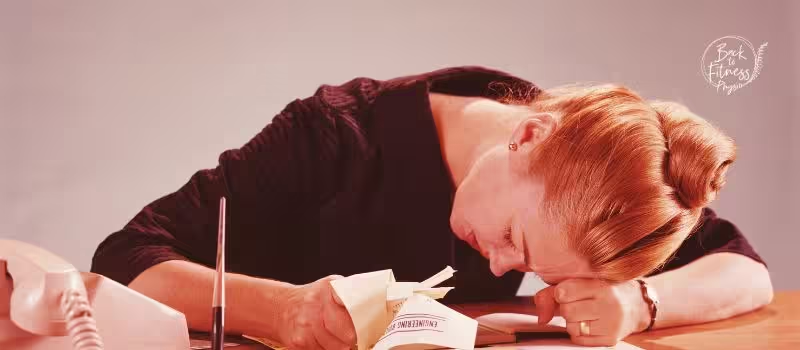Fix up, look sharp! If rounded shoulders (or ‘’mom posture’’) is getting you down, you’re not the only one. Demanding schedules and more screen time means poor posture on the rise, but there are plenty of ways to correct it. Read ahead for all everything you need to know about refining your posture, for good.
Ever heard of ‘’mom posture’’? This refers to rounded shoulders, a form of poor posture caused by being in slumped positions over an extended period of time.
In this blog, we’ll be covering:
- What causes rounded shoulders?
- What problems can rounded shoulders cause?
- What does a bad posture look like?
- Can rounded shoulders be reversed?
- What is the exercise for rounded shoulders?
- How long does it take to permanently fix bad posture?
- Key takeaways & considerations
If you’re a mum, you’ll no doubt relate to the ever-growing list of tasks each day holds. Whether you’re picking the kids up, carrying them, washing up, cooking, or attempting to nail bath time in under 30 minutes (power to you), it’s amazing how much of our time is spent being hunched up in a somewhat compromising position.
And the heavier the little ones get, the more upper back strength is required to hold them.
Sound familiar? Don’t worry! We’ve got your back. Keep reading for the best rounded shoulder exercises to get your alignment in check for stronger days ahead…
What causes rounded shoulders?
Mom posture tends to start during pregnancy. From bearing a growing bump to delivery (both natural and caesarean), the impacts of pregnancy can cause a generalised weakness over the nine month course.
But it’s not just mum’s that get the hunch.
Other common causes of rounded shoulders include:
- Sitting down for long periods of time
- Overuse of devices (phones, iPads, laptops)
- Frequently carrying heavy bags
- Driving vehicles
- Bending over incorrectly
So, if you spend a majority of your 9-5 sitting at a desk or blasting 90s tunes on the road, it’s time to take note.
What does a bad posture look like?
At this point, you’re probably wondering, ‘’how can I check if I have rounded shoulders?’’
If you suspect your shoulders look more ‘hunched’ than they once were, your posture could probably use a little love.
Of course, like with all conditions, it’s important to seek a formal diagnosis from a professional. This means they can devise a tailored program to act as the backbone (ahem, pardon the pun) to your recovery.
That’s where your physiotherapist comes in.
At Back to Fitness, we’ll carry out a postural assessment on your alignment before testing which muscles are lengthened and weak or shortened and tight. We can then provide you with the right rounded shoulders exercises to target your specific problem areas, all while factoring in what’s realistic for your unique schedule and lifestyle.
The result? Happier muscles for a healthier life.
What problems can rounded shoulders cause?
Whether we like it or not, today’s fast paced culture is showing no signs of slowing down. And while it can be easy to push our posture down to the bottom of the priority list, leaving it untreated can lead to long-term consequences.
When our shoulders move forward from the body’s natural alignment, the pec muscles and biceps need to work harder to compensate. This leads to tightness at the front of our chest.
Uncomfortable? You bet. But this can also make it harder to practise deep breathing – not exactly ideal for stress management.
Rounded shoulders also lead to lack of strength building and weakened upper back and core muscles, all of which result in persistent aches and pains.
That’s why it’s important to be aware of what your resting shoulder position looks like. Once you spot the red flags, you can nip it in the bud before it has a chance to worsen.
Is it too late to fix rounded shoulders?
Let’s get one thing straight: having mom posture doesn’t make you forever broken. By mastering the right rounded shoulders exercises, it can be fixed.
The one condition? You have to commit to the process.
This starts by targeting our postural muscles to hold a better posture. These are the core stability muscles nestled deep in your abs, pelvic area, and back. Just think of them a bit like invisible shapewear keeping everything in place.
Addressing our abdominal strength and controlling our back strength is key here. But this is particularly important for the muscles we use to pull with, including the scapula retractors, triceps, and rhomboids (aka our ‘rowing muscles’).
If you’re able to make time in your schedule to get to the gym, great! Make the most of the lat pulldown and rowing machines, and practise your bent over rows to get those postural muscles in check.
But if you can’t make it out of the house? No sweat. There are plenty of simple exercises you can do from home using everyday objects you’ve got lying around.
That heavy nappy bag can be a surprisingly good dumbbell alternative for practising bent over rows, while inverted rows can be done underneath the dining table.
And if you can’t separate ‘me time’ from ‘mum time’, don’t be afraid to get the kids involved, too.
Reverse flies can be done while lying on the floor during playtime, and you can even work the abs by balancing your baby on your tummy for extra intensity and fun. It’s a win-win all round!
Keep in mind that exercises like rows don’t need to be done every day to build strength, however postural exercises should be practised as much as possible to achieve results.
The best postural exercises include:
- Downward-facing dog
- Child’s pose
- Glute bridge
- Pigeon pose
- Isometric pulls
- Cat-cow
- Plank position
No matter how busy you are, carving out a quick five minutes each day to get on the mat and stretch can make all the difference over time. Trust us: you’ll thank yourself in the long-term.
How long does it take to permanently fix bad posture?
The time it takes to correct rounded shoulders depends entirely on its severity and the individual. But since we all like to have *some* idea of when the hard work will pay off, you can start to see noticeable results within the first couple of months. That’s all providing you keep on top of your exercise program and commit to those daily stretches, of course. Good things take time, right?
Key takeaways:
And that’s a wrap! Now we’ve covered all bases of bad posture, here’s a quick summary of the key takeaways you can use when starting your own muscle recovery journey.
- There are many factors of modern life that can lead to rounded shoulders, so don’t be hard on yourself if the slouch has taken a hold on you. Being aware of the causes is the first step to making positive changes.
- Seeing a physiotherapist is a sure-fire way to ensure you’re managing your recovery properly. The last thing you want to do is cause injury by jumping straight in at the deep end, so be sure to seek a helping hand that can support you along the way.
- Leaving rounded shoulders untreated can lead to weakened muscles, aches and pains, and a tightened chest which have a long-term impact.
- The good news is it’s never too late to work on correcting bad posture. With the right program, you can reverse its impact and feel proud as the results take effect.
- Practising commitment, consistency, and compassion with yourself is key for seeing the process through. You’re doing great simply by showing up for yourself!
Considerations
As with most postpartum exercises, it’s important to get expert advice when starting a strengthening program. The guidelines are different based on how you gave birth, so always be sure to check with a professional on a routine that will work for your individual needs.

